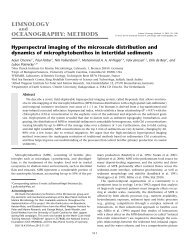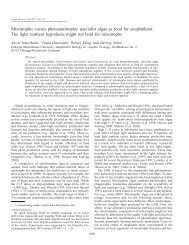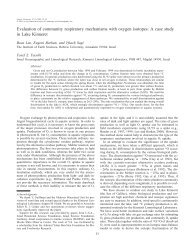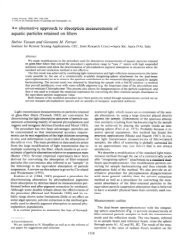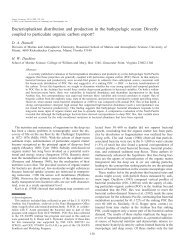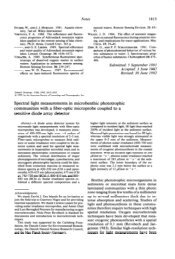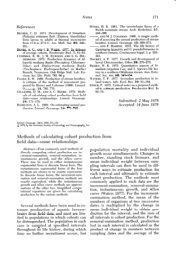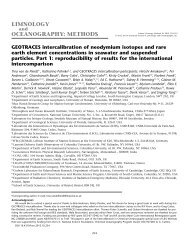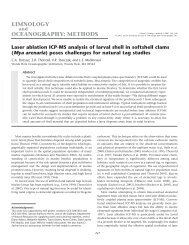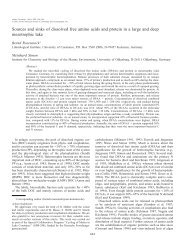Download - ASLO
Download - ASLO
Download - ASLO
Create successful ePaper yourself
Turn your PDF publications into a flip-book with our unique Google optimized e-Paper software.
1772<br />
Notes<br />
J<br />
1.0<br />
2<br />
E 0.9<br />
L<br />
2 0.6<br />
P<br />
< 0.7<br />
t 0.6<br />
0.010<br />
1 10 100<br />
Velocity, cm s-1<br />
Fig. 3. Plot ofclod card weight loss vs. velocity through<br />
32o/oo seawater for data from Glenn and Doty (1992) used<br />
in the form of Eq. 3 (their data extend to higher velocities<br />
than our work). The slope of the regression line is<br />
0.838kO.042.<br />
0.5<br />
0.4 r I<br />
0 5 10 15 20 25 30<br />
Temperature, "C<br />
Fig. 4. Correction factor for clod card data with T,, =<br />
298°K and pref = viscosity of pure water at 25°C. The four<br />
lines correspond to salinities of 0, 10, 20, and 40%~ from<br />
top to bottom. Calculated with viscosity data from Riley<br />
and Skit-row (1975).<br />
(e.g., Cussler 1984; Sherwood et al. 1975; Skelland<br />
1974). For solids of sample geometries<br />
which dissolve uniformly, the area and weight<br />
relationship can be approximated as<br />
A (2)<br />
Ai and Wi represent the initial area (exposed)<br />
and weight of the solid. For clod cards, this<br />
approximation is useful until > 50% of the clod<br />
has dissolved or longer, depending on the velocity<br />
of the fluid.<br />
The mass transfer coefficient is also influenced<br />
by the change in clod dimensions; however,<br />
the effect is usually minor until well into<br />
the dissolution process. Equations 1 and 2 can<br />
be combined and integrated to give<br />
1 - (?r = ;k($A,. (3)<br />
Wr is the final weight of the clod after time 8<br />
has elapsed. Equations 3 is useful for data analysis;<br />
the mass transfer coefficient usually varies<br />
with the fluid velocity raised to a power (P),<br />
so a log-log plot of [l - (WJ/ Wi)“] against<br />
velocity should yield a straight line. This is<br />
illustrated in Fig. 3 with the data of Glenn and<br />
Doty (1992). Equation 3 can be rearranged to<br />
give an expression for the overall fraction of<br />
weight 10~s (A W/ Wi):<br />
Assuming that AC remained constant during<br />
dissolution, experimental data at a given temperature<br />
and salinity were correlated with the<br />
model<br />
( )<br />
l/3<br />
Wf = aVm.<br />
I- j7<br />
I<br />
The constants a and m can be determined experimentally<br />
by means of the rotating arm, and<br />
weight loss data from clod cards exposed in<br />
the field can then be used in Eq. 5 to determine<br />
water motion.<br />
The effect of temperature at a given salinity<br />
and CaSO, concentration was corrected by using<br />
the group (T/T,,) (p,.,&) to normalize data<br />
to a reference temperature, where Tis absolute<br />
temperature, and p is viscosity. This group (Fig.<br />
4) is typically used to estimate the changes in<br />
diffusion coefficients (Reid and Sherwood<br />
1966) with varying solution strength.<br />
From Eq. 1 and 3, the dissolution rates are<br />
also dependent on the concentration of CaSO,<br />
in the bulk water and factors influencing the<br />
concentration, such as the ionic strength of the<br />
bulk water. To determine the concentration<br />
difference, we assume the solution at the gypsum-water<br />
interface is saturated with CaSO,<br />
and determine AC with the solubility product<br />
as<br />
Ksp = [Ca2+]i[S042-]i<br />
g= 1 - 11 - ;k($)ACO13. (4)<br />
or<br />
= ([Ca’+], + AC)([S042-]b + AC) (6)




